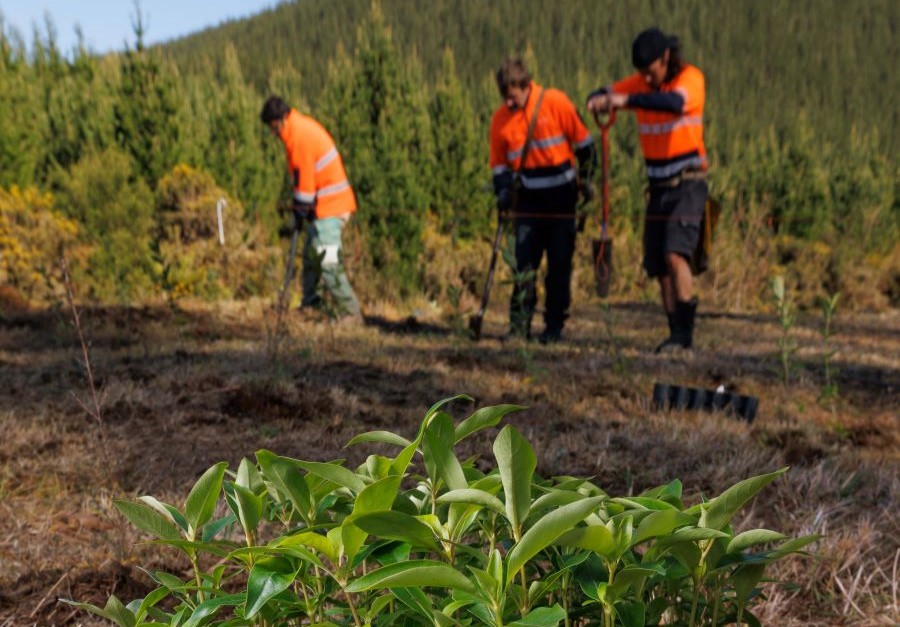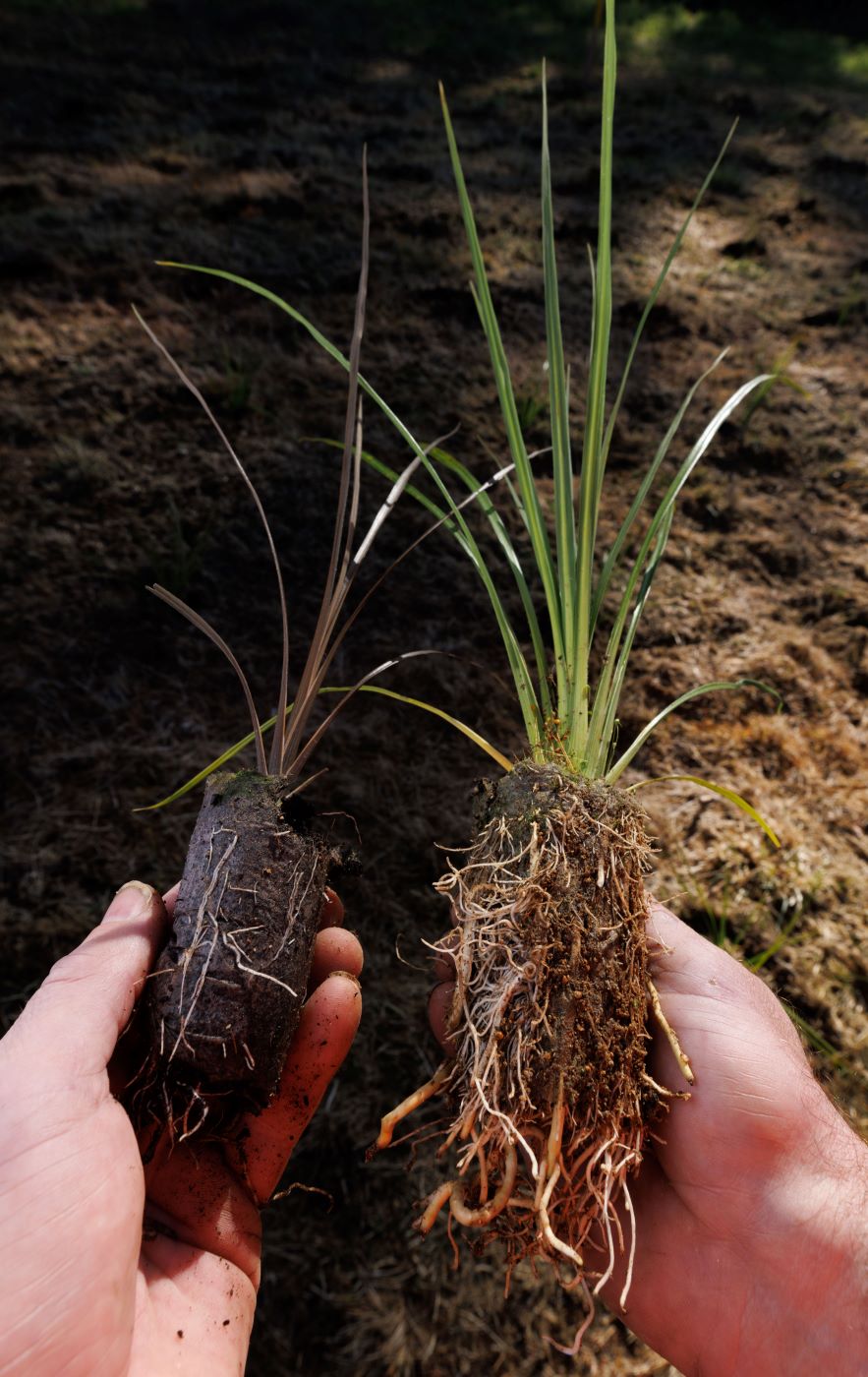Mini but mighty
A new hedge system and alternative containers are being trialled to scale up indigenous tree propagation.

Scion has broken ground and is making progress on several new field trials following successful trials propagating native seedlings in paper Ellepots.
More than 15,000 karamū, mānuka, tōtara and tī kouka seedlings were planted in August 2023 at two sites in Rotorua.
The work is progressing propagation research towards forestry-scale deployment of indigenous species under New Zealand’s One Billion Trees (1BT) Programme.
Producing large numbers of indigenous species is currently a slow, expensive and uncertain process. Challenges include collecting and germinating seed, maintaining efficiency while working at a small scale and issues around adopting modernised practices. The goal of every nursery is to cost-effectively produce robust and vigorous plants that establish quickly, and this has proven difficult when it comes to many indigenous tree species. For example, pot sizes tend to be large, which adds to the cost and logistical challenges of establishment compared with smaller ‘forestry grade’ pots.
Since 2019, Scion has been collaborating with Te Uru Rākau - New Zealand Forest Service and various industry partners to develop new ways to improve propagation and the scaling up of indigenous species production in nurseries.

On track to one billion trees
In 2018 the previous Government set a goal to plant a billion trees by 2028. To reach this ambitious goal requires producing seedlings at scale.
Funded by Te Uru Rākau - New Zealand Forest Service, Scion, in collaboration with Minginui Nursery, Tipu Wai Trust, CNI Iwi Land Management Ltd, Tumunui Lands Trust, Te Arawa Lakes Trust and Rotorua Lakes Council, has completed several projects to help nurseries produce the required number of native seedlings.
“This work is addressing a real issue for native afforestation as our indigenous trees are traditionally much harder to propagate and establish compared to exotic species”, says Dr Emily Telfer, Te Uru Rākau – New Zealand Forest Service Team Leader, Forestry Research Programme.
The 1BT programme is on track with well over half the target number of trees already planted. A further 150 million seedlings are estimated to be planted in 2024.
The 1BT Fund is closed for applications, with the programme continuing until 2028 for grants that have already been approved.
New production practices – mini-hedges
As part of this work, a new system for supplementing native tree seedling supply was tested in Scion’s nursery to address native tree seed availability and supply challenges. Establishing seedlings in long rows to create “mini-hedges” can provide harvestable shoots year-round, avoiding the seasonal limitations of many New Zealand natives. The mini-hedge system has proven to accelerate the production of high-value genetically improved plants such as radiata pine and eucalyptus, but this is the first known use of this approach for New Zealand native trees.
Between March 2020 and April 2021, Scion’s nursery team grew eight native species using the purpose-built mini-hedge system. These were incredibly productive and several rounds of harvesting and setting of cuttings were achieved. Most species responded well to the environment – tawhai (silver beech) the notable exception with its low tolerance to higher temperatures throughout summer. Rooting success varied from 30% up to 99%. Tōtara (Podocarpus totara) and pōhutukawa (Metrosideros excelsa) were the most successful species at 99% and 80% respectively.
Three hundred and fifty seedlings of each species were sown into paper pots, planted into beds in the nursery and, once sufficient shoot material was available, they were harvested and placed into rooting tunnels on heated beds. Eight to 12 weeks after setting, rooting success was evaluated.
Scion scientist Heidi Dungey discusses the potential benefit of this system: “Many New Zealand native trees do not have reliable seed production. The mini-hedge system may be a great way to ensure supply of plants when seed is not in sufficient supply.”
This research also indicates that the nursery production time of native seedlings like tōtara and pōhutukawa might be shortened, and year-round supply might be possible.
Container field trials
The conventional approach of sowing native seed, setting out and then growing in containers takes 12-36 months, adding significantly to native tree establishment costs over typical New Zealand-grown exotic forest trees.
In Scion’s research nursery, 31 indigenous tree species were included in the propagation trial investigating container type and container size. Industry standard pots were compared with other, smaller containers such as paper Ellepots and forestry grade pots. Both slow-growing and fast-growing indigenous species were included.
Over 15,000 seedlings of four different tree species – karamū, mānuka, tī kouka and tōtara – were established in forestry grade (industry standard) pots, or 7cm and 8cm paper Ellepots. The effect of differences in length of time, type of container and tree spacing are being monitored to determine the impact on survival rates and tree growth.
Tipu Waiariki Charitable Trust (Tipu Wai) is supporting the research by providing a trial site for planting. Trustee Gregg Brown says the partnership with Scion is incredibly rewarding. “We have enjoyed a partnership with Scion over many years and are grateful for the opportunity to contribute in our own small way to addressing the environmental challenges in New Zealand.”
Scion project lead for the latest field trials, Donald White, believes these plantings will act as a basis for future research and collaboration. “Understanding the fundamentals of how native trees grow will help us prepare for climate change.”
Dungey stresses that the mini-hedge system is exciting for native tree production. “Any concerns for diversity can also be managed through the diversity of the mother plants.”
When combined with smaller, robust plant production, this will be a game-changer for native forest establishment.
“There is so much to do to help establish native forests across the motu, that every little bit of new or old knowledge counts.”
This research has already impacted the New Zealand nursery sector, with investment into paper pot technology in several nurseries.
“Combined with new forest establishment research, we hope that this will result in more plantings of native forests, increasing our biodiversity and contributing to the mitigation of climate change.”
